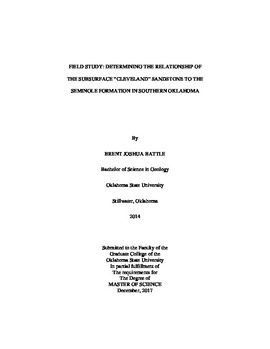| dc.description.abstract | The Cleveland sandstone is a fluvial-deltaic, Pennsylvanian Age formation in Oklahoma that produces hydrocarbons in the subsurface and is exposed at the surface in the outcrop trend that extends from Seminole County north-northeast into Hughes, Okmulgee, Okfuskee and Tulsa counties, where it is known as the Seminole Formation. The purpose of this study is to verify the relationship between the Cleveland sandstone and the Seminole Formation, and to determine the provenance of these sediments. Previous works evaluated either the subsurface Cleveland sandstone or studied the Seminole Sandstone in outcrop, but this study correlates subsurface stratigraphy to the surface. Eight outcrops of the Seminole Formation were sampled for petrographic analysis, and surveyed with a gamma ray spectrometer readings to identify the Nuyaka Creek "hot" Shale marker that is exposed in two of the southern outcrops. Based on previous work by Bacon (2012), and corroborated by this study, the Nuyaka Creek Shale is the key marker bed for the Desmoinesian-Missourian boundary. The field API gamma ray readings allowed correlation to API gamma ray signatures in nearby wells. Three cross sections were prepared. Cross-section A-A' is a stratigraphic cross section containing 21 wireline logs, hung on the Checkerboard Limestone, (tied to Cross-section A-A' by Bacon (2012)), that starts in central Oklahoma (Kingfisher County) and extends southeast across the Anadarko Shelf, the Nemaha Ridge, the Cherokee Shelf, and into the Arkoma Basin (Seminole County). Cross-section B-B' is a to scale structural dipline trend, that correlates the Seminole Formation from the outcrop into the subsurface. Cross-section C-C' shows the stratigraphy along the outcrop trend. This study confirms work by Bacon (2012) that the Nuyaka Creek "hot" Shale marker, identified in both subsurface and outcrop, is a useful lithostratigraphic boundary between the Missourian Stage and Desmoinesian Stage. Petrographic analysis of outcrop samples demonstrates two sediment source areas: Ouachita Uplift (cryptocrystalline chert) and metamorphic rock fragments. Finally, this study agrees with previous work and concludes, that where the Checkerboard Limestone is absent as it approaches the outcrop trend, it is likely stratigraphically equivalent to the DeNay Limestone. | |




